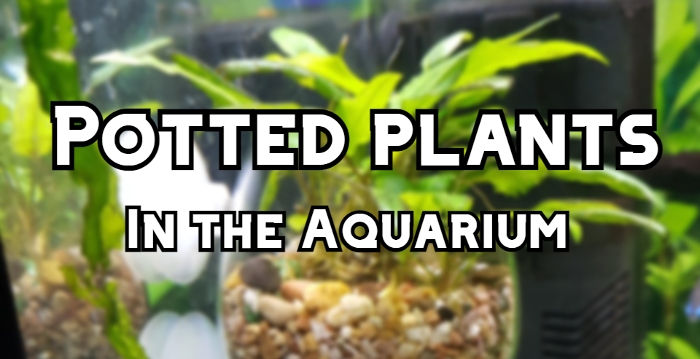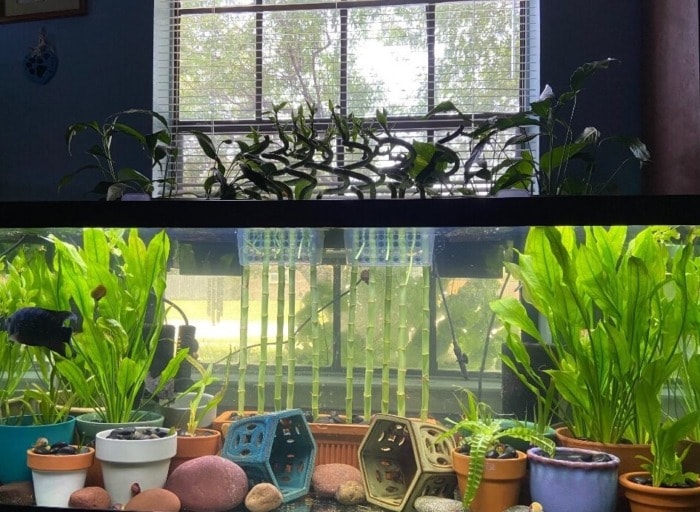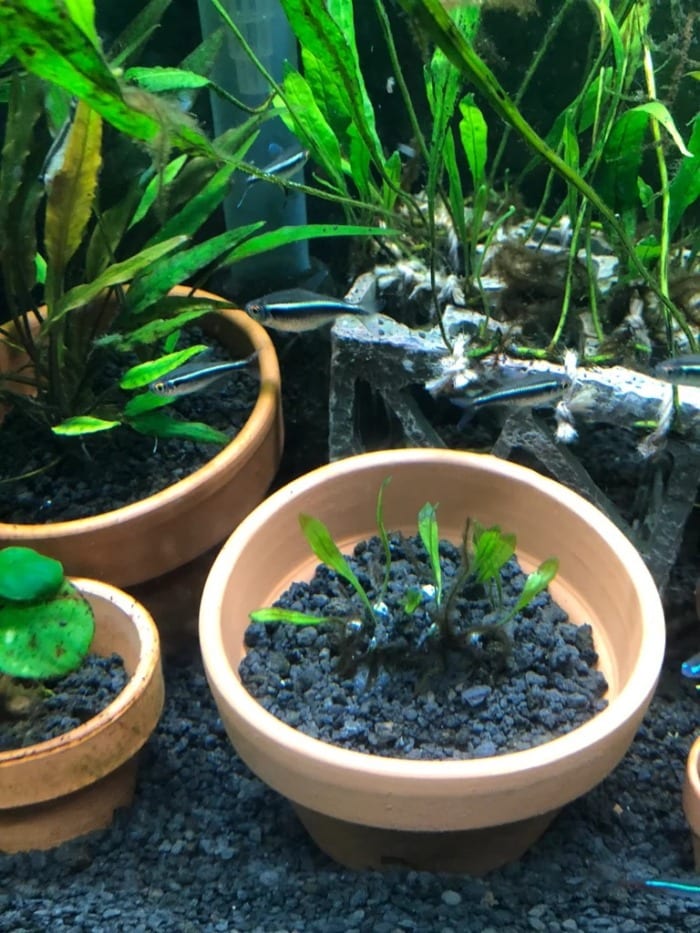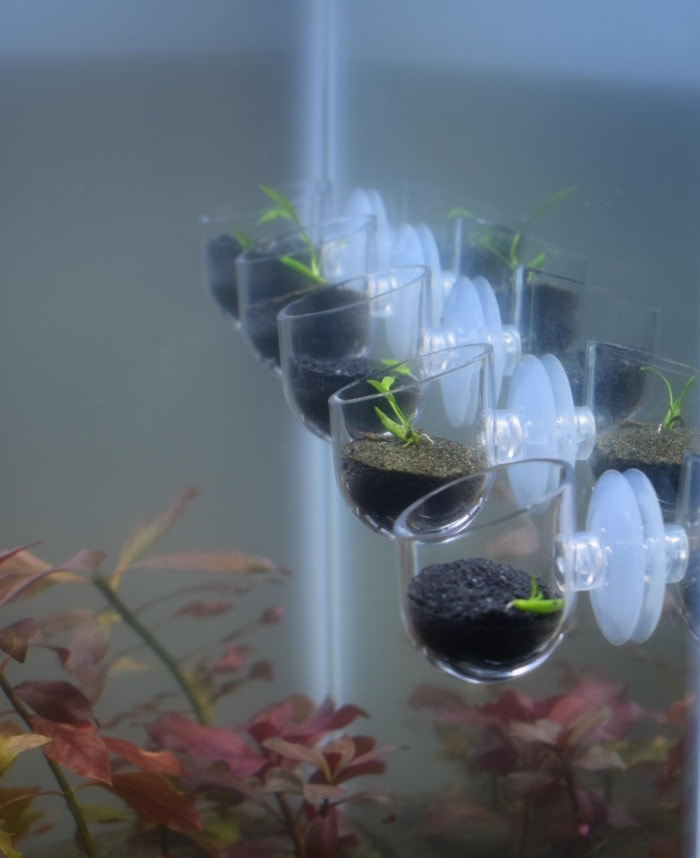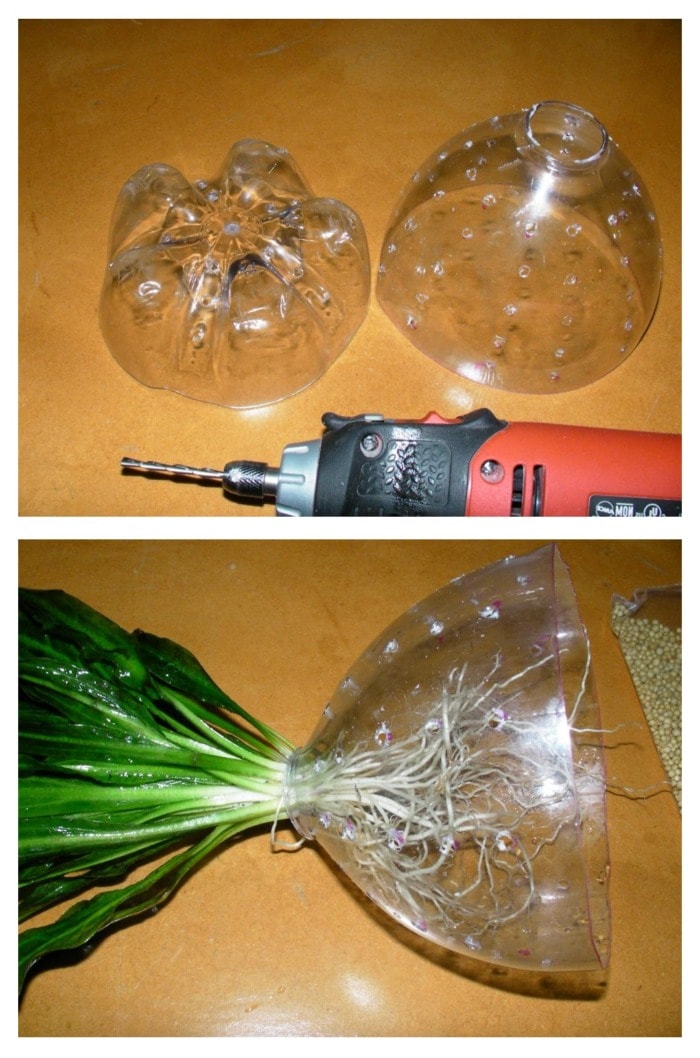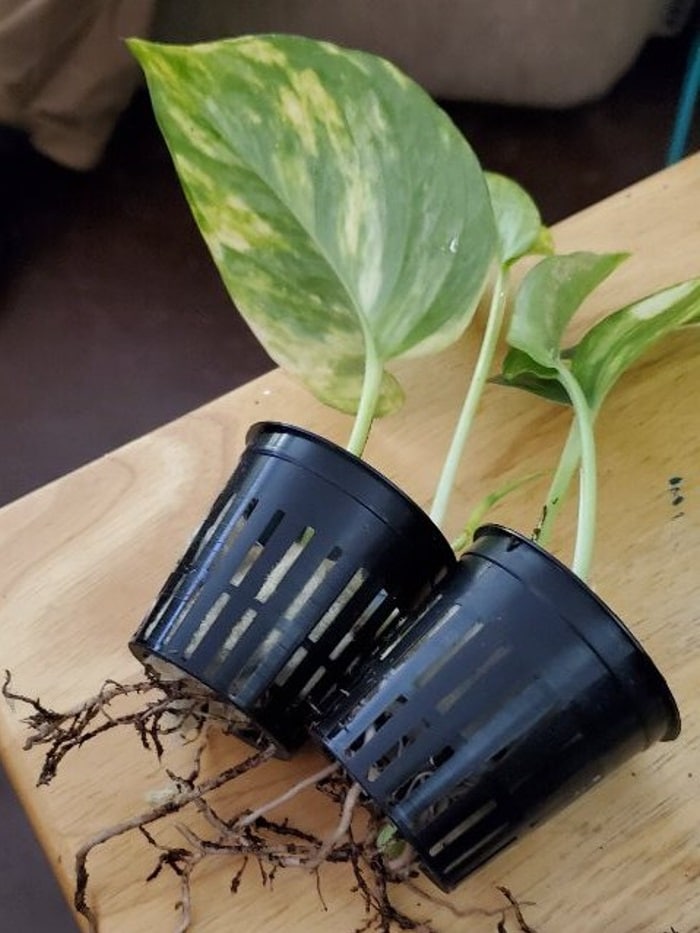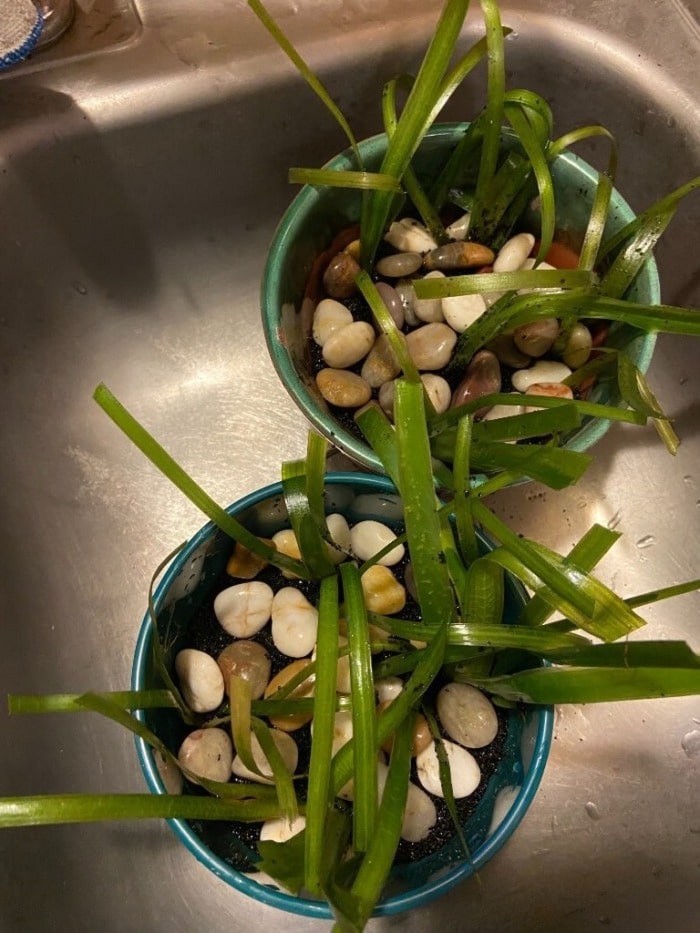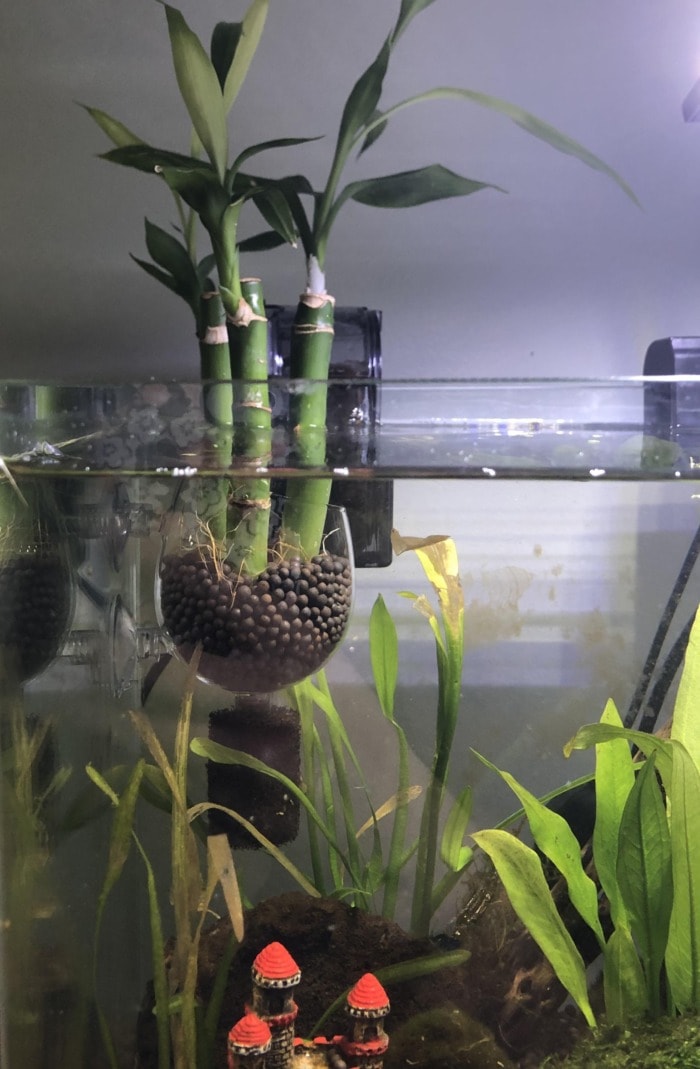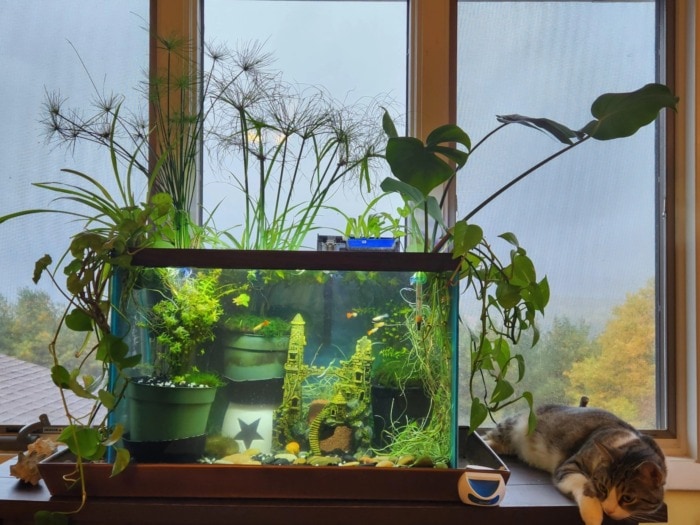In the past, I wondered if my life would be easier without the difficulties of aquascaping.
This got me wondering if I could get potted plants and leave them in my aquarium without any extra care.
After obsessing over this idea for a few days, I did some research on planters.
I had some interesting revelations about using potted plants for my aquarium that finally ended my pot obsession.
Can potted plants be used in an aquarium?
Creating a heavily planted tank takes a lot of effort, patience, and consideration, and doesn’t always go as you might expect.
This leads many aquarists to seek an alternative to this laborious and sometimes frustrating procedure.
And some see the solution to this problem in potted plants.
Here’s why you can decorate your aquarium with potted plants:
It is perfectly safe to use potted plants in an aquarium as long as they are placed in an appropriate container. The container should be plastic, glass or clay and should not contain artificial colors or chemicals that could leach into the water.
by Odd Duck
Using potted plants is not only safe, but also allows you to:
- combine plants with different growing requirements
- provides refuge for finicky fish
- promotes gas exchange.
In addition, potted plants are also protected from destruction caused by small rogues such as goldfish and the like. Unlike typical bare root aquarium plants, potted plants can also be easily moved when needed.
How to plant potted plants in an aquarium?
1. Choose the right jar
The choice of a pot will depend on certain practical aspects such as the type of plant and its growth rate as well as more subjective aspects such as its shape.
I’ve summarized all the types of pots you can use with the pros and cons of each.
Here are all the different types of pots that can be used in an aquarium:
plastic jars
by Wyvc
As long as they are thoroughly cleaned, plastic pots can be used to grow potted plants in your aquarium. They are completely safe and will not significantly alter the water chemistry of your freshwater aquarium.
After all, some filter components and other aquarium equipment are made of plastic and do not affect the well-being of our pet fish. However, the pots should have holes in the bottom so that there is room for root growth.
Otherwise, the plants will die once they have exhausted all the nutrients in the substrate.
Apart from their low price, plastic pots also give you a lot of creative freedom.
You can use a variety of plastic containers and use them as pots.
One of the advantages of plastic pots is that they are not porous and retain more oxygen than terracotta pots.
Terracotta pots
by RamonManuel
Terracotta pots can be found at any garden supply store and look much better in an aquarium than plastic pots.
The ones you should watch out for have a solid reddish hue. They may not look as nice as painted terracotta pots, but they don’t contain any artificial colors that can leach into your aquarium water and poison your fish.
You should also be careful with glazed terracotta pots as they can also impact the health of your fish by releasing toxins into the water.
Before adding them to your tank, you should rinse them with hot water to remove any impurities they may contain.
What makes small terracotta pots great is that they can also be used as a form of decoration in different ways.
You can turn them into caves by drilling a hole and turning them upside down, which will be much appreciated by some more shy species of fish.
Alternatively, you can break them up into pieces and scatter them around the bottom for a more natural look.
If you go this route, smooth out any sharp edges that can hurt your fish before adding them to your aquarium.
Glass jars
by TheJimness
I love using glass jars as aquarium planters because of their versatility.
The suction cups on these pots allow you to place them anywhere in the tank, which is very useful when you want to create more verticality in your aquascape.
Glass jars are also cheaper than terracotta jars and simply look better than them.
They have permeable holes on the bottom which help with water circulation and oxygen uptake and enhance the effects of photosynthesis.
The only downside to these pots is their small size which limits your option for aquarium plants.
Slow growing live plants like Cryptocoryne wendtii, Anubias Nana Petite and Blyxa japonica are suitable options.
DIY Aquarium Planters
by M1STE2TEA
If you’re feeling creative, you can also make your own aquarium planter from scratch.
All you’ll need for this is a two-liter bottle of soda, a Dremel tool, and a spark of creativity.
Here’s how:
- Cut the top and bottom parts of the bottle so that the top slips over the bottom.
- Drill a few holes with the Dremel tool.
- Fill the bottom with substrate and add a fertilizing root strip if necessary.
- Put the plant inside the top of the planter.
- Finish by gluing the two parts together.
And before you ask, super glue is safe for pet fish.
Another idea for a DIY aquarium planter is to simply drill the bottom of a yogurt pot and fill it with substrate.
It may not look aesthetically pleasing, but it’s still an option and requires less effort.
2. Remove the plant from its original pot
by Alesha
Your next step should be to take the plant out of the pot it originally came in.
To do this, simply cut off any bare roots that are outside the pot and remove the plant.
However, before your plant is ready for transfer, you need to remove the woolly substance around its roots.
This substance is a hydroponic substrate called rockwool.
Rockwool is made from molten basalt rock fibers and is used to prevent overwatering and root choking in hydroponic plants. Unfortunately, rockwool does not break down and can harm your fish by blocking their gills or ending up in their digestive tract.
It can also upset the water chemistry by clogging the filter wheel and disrupting the water flow in the aquarium. To avoid all of these dire scenarios, simply soak the base of your plant in water and carefully remove the rockwool around its roots.
After doing this, you can proceed to the next step.
3. Fill the new pot with substrate and place the aquarium plant in it
by Odd Duck
You can use a variety of inert and depleting aquarium substrates to suit your plant’s needs. Regular soil, specialized water soils, and gravel are all great choices, but you should avoid using sand as some will slip through the gaps in the bottom of the pot.
I prefer to use a combination of water soil and gravel as a “plug” because water soil provides a more sustainable source of nutrients than roots. To prepare the substrate, I start watering the aquatic soil until it becomes slightly muddy, after which I fill the pot with it.
I then get rid of the air bubbles from the substrate by gently pressing on it. Before placing my plant there, I make a hole in the center to make room for its root system.
After planting it in the ground, I bury the roots and top of the soil with gravel.
This helps hold the plant in place so it doesn’t bend or fall out of the pot.
Can you use houseplants as potted aquarium plants?
by shelbsbelbs
Although houseplants can be grown in an aquarium, planting them in pots and immersing them in your aquarium will not always give you the same result as a typical aquarium plant.
This is because some indoor plants will not be able to extract enough oxygen from the water and will die as a result.
However, some of these live plants can still be used for an aquarium if their roots are planted in water, but their stem and leaves are left on the surface.
In the aquarium hobby, houseplants that fall under this description are classified as “emerged”, while those that can be grown entirely underwater are called “submerged”.
Dracaena Sanderiana is a houseplant that can be grown in an aquarium with the right care. The Epipremnum aureum from Araceae family, or Pothos plant as it is most commonly known, is also among the most popular houseplants in the aquarium community.
Pothos can be grown in a number of ways, planting them directly in the HOB filter or placing them in a glass jar inside the aquarium.
Unfortunately, pothos is toxic to cats and dogs.
by OliBoliz
If you own one of these furry animals, you may want to consider a safer alternative, such as one of the following:
- Bella Palm (Chamaedorea Elegans)
- Philodendron (Philodendron Araceae)
- Peperomy (Peperomia Piperaceae)
- Snake Plant (Dracaena trifasciata)
- Roman chamomile (Noble Chamaemelum)
- English lavender (Lavandula angustifolia)
- Prayer Plant (Maranta leuconeura)
These, of course, do not encompass all houseplants that can be used in an aquarium, but that is an entirely different topic in itself.
my last words
Adding potted plants to your aquarium can definitely add flavor and save you effort.
If you already have a setup with potted plants, you can share your experience in the comments.
Sharing is caring!


